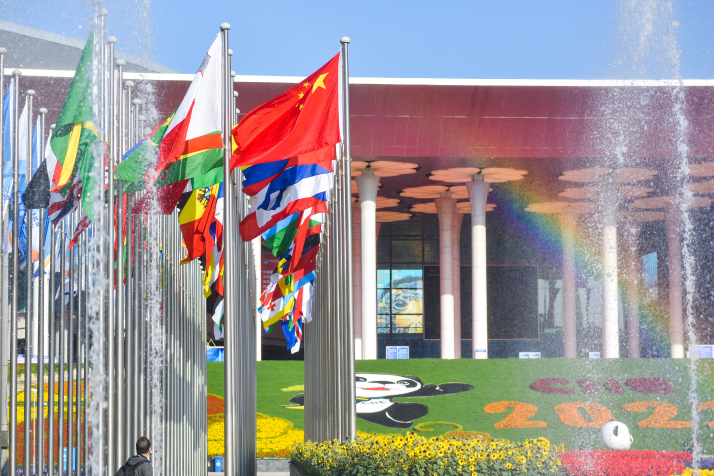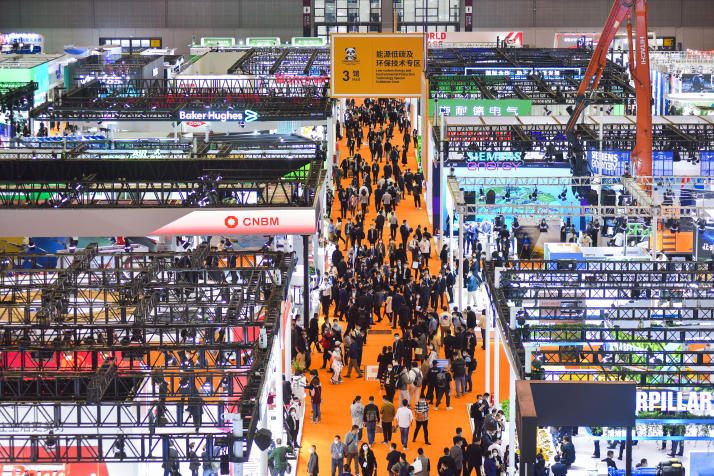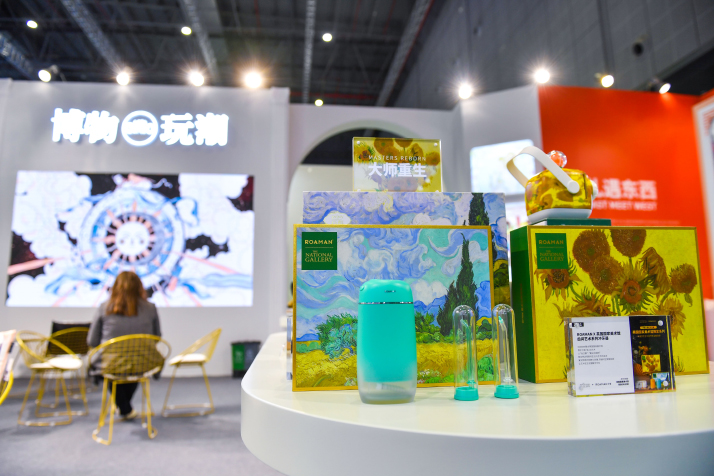| Business |
| China's annual import expo continues to generate new opportunities | |
|
|
 The National Exhibition and Convention Center in Shanghai, venue of the Fourth China International Import Expo (CIIE), on November 7 (WEI YAO)
Amid lingering challenges brought on by the COVID-19 pandemic, the Fourth China International Import Expo (CIIE), held in Shanghai from November 5 to 10, still managed to attract global participants and saw the enduring enthusiasm of domestic buyers and traders. More than $70.7 billion worth of tentative deals were reached for one-year purchases of goods and services at the event, Sun Chenghai, Deputy Director of the CIIE Bureau, told a press conference after its conclusion. Inaugurated in 2018, the CIIE is the world's first import-themed national-level trade show. This year's edition, in a first-ever, launched an online country exhibition. According to the CIIE Bureau, a total of 58 countries and three international organizations participated, with five making their CIIE debut. The business exhibition again covered six areas: food and agricultural products, automobiles, technology, consumer goods, healthcare and trade in services. Nearly 3,000 companies from 127 countries and regions made an appearance, covering an offline exhibition area of 366,000 square meters—expanding on the 2020 edition. Among the 281 participating Fortune 500 companies and industry leaders, 40 attended the expo for the first time and 120 were fourth-time participants. A total of 422 new products, technologies and service solutions were presented during the expo, marking a record high. The medical equipment and healthcare products category contributed the largest share, with 135 novel goods. As Wang Shouwen, Vice Minister of Commerce, told an expo forum on November 5, China has a large market boasting expanding and increasingly diversified and upgraded demands. Despite the epidemic, it has seen resuming consumption since the beginning of this year. Chinese consumers are eyeing greener, healthier and better goods and services. "China has been driving its imports in recent years by lowering tariffs, developing pilot free trade zones, boosting cross-border e-commerce and hosting trade events such as the CIIE. China's domestic demand has become a strong driving force of its own economy and also shored up global economic growth," Wang said. Inspired by this year's results, many participants took early action with up to 150,000 square meters of exhibition area already booked for next year's expo, the CIIE Bureau added.  Visitors at the exhibition zone of low-carbon energy and environmental protection technology at the Fourth China International Import Expo in Shanghai on November 6 (WEI YAO)
Smart thinking For many global enterprises, the CIIE provides a platform to exhibit their latest innovations. Jeffrey Xu, Senior Vice President of 3M, a U.S.-based multi-manufacturer, told Beijing Review that the company participated in the expo for the fourth consecutive time this year. Since the first edition, it has showcased innovative products which included earplugs that can help protect a user's hearing in a noisy environment as well as various recycled thermal materials. This year, Harvest RC technology, a solution that proves simpler than most conventional ones and can help reduce the production costs of drugs and vaccines, debuted on the Chinese market. U.S.-based Boston Scientific exhibited a device that offers remote monitoring for arrhythmia sufferers and an implantable cardiac event monitor. These devices can create more suitable and targeted treatment. As China seeks industrial restructuring, intelligent technology suppliers are sensing rising opportunities in the market. Japan-based Nachi-Fujikoshi is also a four-time participant in the expo. It was among the first multinational companies to sign up to take part in the First CIIE in 2018, and went on to establish a subsidiary in Shanghai in 2019. This year, it exhibited industrial robots for welding and construction. According to Liu Xiaobing, Deputy Director General of Nachi (Shanghai) Co. Ltd., its businesses resumed swiftly in 2020 after weathering epidemic-induced afflictions and even reached a record high in May last year as the epidemic actually resulted in the increase of demand for unmanned technologies and facilities. With China's shift from a global factory to a manufacturing power, consumer demand is bound to grow in the post-epidemic era. Swiss-based industrial company ABB is also optimistic about further developing its robot business in China. The company exhibited diverse products and solutions, including one of its star products called YuMi, a collaborative dual-arm robot. Lars Eckerlein, General Manager of ABB (China), told Beijing Review, "China is ABB's largest robotics market. We have now spotted room for the further development of the business here, given global challenges such as labor shortages caused by rapid urbanization and climate change equally apply to China. The shortages can be addressed via industrial upgrading and the expansion of robotics and machine automation technologies." Moreover, robot density, meaning the number of robots per 10,000 workers, has been snowballing in China over the past years, and has not yet reached similar levels in other countries. "ABB is constructing a new production facility worth $150 million in Shanghai, which will open in the first half of 2022. It will be a factory where robots are used to assemble new robots for advanced and automated production. We are optimistic about the development in the Chinese market and will therefore keep investing in it," Eckerlein added.  A jacket made from recycled plastic bottles is on display at the booth of French food group Danone during the Fourth CIIE on November 5 to 10 (XINHUA)
Green and clean While expanding business and increasing investment in the Chinese market, multinationals are adjusting their development roadmaps to echo China's goals for achieving carbon neutrality before 2060. Germany-based chemical company Covestro debuted at the expo this year with one of its key technologies, namely Triturn CO2 technology, which enables carbon dioxide to be reused as an alternative raw material in polyol production to replace up to 20 percent of fossil feedstock. Polyol can be used to create mattresses, fabric materials and decorative products for vehicles. ABB presented a system to screen greenhouse gases occurring in the air across different environmental settings. It also showcased a platform for the monitoring and adjusting of overall power use in buildings, through which users can save energy when demand is low—and even sell the extra electricity to those in need. The platform has been applied in ABB itself and several of its business partners. Air Products, a U.S.-based industrial gas supplier, brought its carbon capture technologies and carbon-free hydrogen project to the CIIE. According to Yu Feng, Vice President of Air Products (China), it has developed diverse technologies to capture carbon during the use of fossil fuels, including the separation of carbon dioxide through ammine and distillation. "Air Products has also introduced technologies for reducing carbon emissions during the production of hydrogen. Our hydrogen station at the venue in Zhangjiakou, Hebei Province, for the Beijing 2022 Olympic Winter Games has already completed successful trials," Yu said. In 2018, the Lu'an coal gasification project of Air Products in Changzhi, Shanxi Province, came into being, supplying syngas and other industrial gases to the syngas-to-oil production of Shanxi Lu'an Coal-Based Clean Energy Co. Ltd. Japan-based printer company Epson exhibited its heat-free printing technology, during which its printers only take up an amount of power equal to that consumed by a domestic light bulb. German engineering and technology company Bosch presented yet another expo highlight, exhibiting auto parts such as windscreen wipers and engines for electric vehicles, which can contribute to reducing energy consumption when driving by reducing the size of those parts, all the while improving the accuracy and durability of operation. During the expo, Bosch signed an agreement to work together with Chinese automaker FAW on smarter and greener transportation. As green consumption becomes a trend, many enterprises have turned to the use of recyclable materials and reducing energy consumption along the manufacturing processes of their products. French food group Danone showcased a jacket made from recycled plastic bottles. International fashion and luxury brands such as Beckmann and Fendi also impressed visitors with their products made from reusable materials. As the Chinese Government works on cutting carbon emissions and enhancing public awareness about the topic, Chinese consumers have started to focus much more on environmentally friendly and organic products, Bruno Chevot, President of Danone Greater China & Oceania, told a CIIE forum on November 5. For enterprises, the key is not only to reduce carbon emissions in production, but also to enhance supply chains to gain access to green raw materials and achieve low-carbon production from the onset, he said.  Cultural products presented at the Fourth CIIE on November 5-10 (WEI YAO)
Upping the game As Chinese consumers develop upgraded demands, global products reaching them via the CIIE fill a domestic market gap. This year, food and agricultural product suppliers from around the globe brought their distinctive features to the expo as always. To promote their sales, many sellers turned to live-streaming. A joint live-stream starring a Chinese online celebrity and a reporter of the state broadcaster China Central Television led to the sales of around 120,000 cans of pine nuts from Afghanistan on November 6, worth more than 10 million yuan ($1.56 million). Daily necessities aside, exhibitors presented diverse products for the bettering of people's lives, ranging from sports-related products to cosmetics and luxuries. Niche demands like pet food were further embraced. U.S. agriculture and food company Cargill brought its new pet nutrition product to the expo this year. According to the company, it can help improve animal immunity. China, with its rising number of pet owners, is a key market for Cargill. The CIIE for the first time established a cultural relics and art section this year, bringing masterpieces to Chinese collectors. The section also displayed derivatives of overseas intellectual properties such as the Louvre and the British Museum. Wang Wei, Director General of the Institute for Market Economy at the Development Research Center of the State Council, told a forum on November 5 that China has seen its domestic consumption expanding from goods to services in recent years. New consumption empowered by the Internet, technological progress and a diversified demand of different customer groups has boomed. These changes have made China a key market for global enterprises, and can also spur on domestic investment, hi-tech applications and service trade.
Exploring potential As China widens its door for new imports, its market sees more room for growth. According to Wang Wei, consumption contributed to 64.8 percent of China's GDP growth in the first three quarters this year, while the world's average level stands at 77 percent. China's opening-up measures have boosted the confidence of multinational enterprises and facilitated their conducting of business in the Chinese market. For a more open market, efforts are needed to reduce areas that prohibit or restrict foreign investment, and develop standards in line with the Regional Comprehensive Economic Partnership and the Comprehensive and Progressive Agreement for Trans-Pacific Partnership, Nie Pingxiang, a researcher with the Chinese Academy of International Trade and Economic Cooperation under the Ministry of Commerce, told Beijing Review. "As China witnesses an accelerated industrial restructuring, the government needs to channel more foreign investment into key sectors such as technology for high-quality development," Nie concluded. (Reporting from Shanghai, with contributions from Ma Miaomiao) (Print Edition Title: Import for Impetus) Copyedited by Elsbeth van Paridon Comments to lixiaoyang@bjreview.com |
|
||||||||||||||||||||||||||||||
|